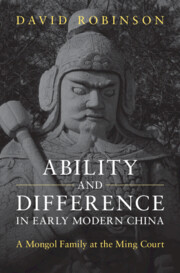Refine search
Actions for selected content:
129 results
4 - Educating the Entitled
-
- Book:
- Ability and Difference in Early Modern China
- Published online:
- 10 September 2025
- Print publication:
- 11 September 2025, pp 82-114
-
- Chapter
- Export citation
9 - Turning Every Page
-
- Book:
- Ability and Difference in Early Modern China
- Published online:
- 10 September 2025
- Print publication:
- 11 September 2025, pp 212-230
-
- Chapter
- Export citation
3 - The Sovereign’s Man
-
- Book:
- Ability and Difference in Early Modern China
- Published online:
- 10 September 2025
- Print publication:
- 11 September 2025, pp 60-81
-
- Chapter
- Export citation
8 - Holding against the Storming
-
- Book:
- Ability and Difference in Early Modern China
- Published online:
- 10 September 2025
- Print publication:
- 11 September 2025, pp 186-211
-
- Chapter
- Export citation
7 - Patronage, Assessment, and Power
-
- Book:
- Ability and Difference in Early Modern China
- Published online:
- 10 September 2025
- Print publication:
- 11 September 2025, pp 163-185
-
- Chapter
- Export citation
Conclusion
-
- Book:
- Ability and Difference in Early Modern China
- Published online:
- 10 September 2025
- Print publication:
- 11 September 2025, pp 247-251
-
- Chapter
- Export citation
1 - An Age of Decisions
-
- Book:
- Ability and Difference in Early Modern China
- Published online:
- 10 September 2025
- Print publication:
- 11 September 2025, pp 23-40
-
- Chapter
- Export citation
10 - Seizing Fortune
-
- Book:
- Ability and Difference in Early Modern China
- Published online:
- 10 September 2025
- Print publication:
- 11 September 2025, pp 231-246
-
- Chapter
- Export citation
Introduction
-
- Book:
- Ability and Difference in Early Modern China
- Published online:
- 10 September 2025
- Print publication:
- 11 September 2025, pp 1-22
-
- Chapter
- Export citation
2 - Dying for His Lord
-
- Book:
- Ability and Difference in Early Modern China
- Published online:
- 10 September 2025
- Print publication:
- 11 September 2025, pp 41-59
-
- Chapter
- Export citation
6 - Far from Home
-
- Book:
- Ability and Difference in Early Modern China
- Published online:
- 10 September 2025
- Print publication:
- 11 September 2025, pp 138-162
-
- Chapter
- Export citation
5 - Representing the Emperor
-
- Book:
- Ability and Difference in Early Modern China
- Published online:
- 10 September 2025
- Print publication:
- 11 September 2025, pp 115-137
-
- Chapter
- Export citation

Ability and Difference in Early Modern China
- A Mongol Family at the Ming Court
-
- Published online:
- 10 September 2025
- Print publication:
- 11 September 2025

The Will in English Renaissance Drama
-
- Published online:
- 04 September 2025
- Print publication:
- 18 September 2025
‘your poore distressed suppliant’: ‘Madness’, Emotion and the Archive in Early Modern England
-
- Journal:
- Transactions of the Royal Historical Society , First View
- Published online by Cambridge University Press:
- 02 September 2025, pp. 1-24
-
- Article
-
- You have access
- Open access
- HTML
- Export citation
Chapter 5 - Dying and Deathbed Practices
-
- Book:
- Birth, Death, and Domestic Religion in Early Modern London
- Published online:
- 17 July 2025
- Print publication:
- 31 July 2025, pp 159-188
-
- Chapter
- Export citation
Chapter 3 - Religious Practices Following Childbirth
-
- Book:
- Birth, Death, and Domestic Religion in Early Modern London
- Published online:
- 17 July 2025
- Print publication:
- 31 July 2025, pp 97-124
-
- Chapter
- Export citation
Chapter 6 - Domestic Religion in the Days After Death
-
- Book:
- Birth, Death, and Domestic Religion in Early Modern London
- Published online:
- 17 July 2025
- Print publication:
- 31 July 2025, pp 189-216
-
- Chapter
- Export citation
Chapter 2 - Childbirth, Religious Practice, and Domestic Space
-
- Book:
- Birth, Death, and Domestic Religion in Early Modern London
- Published online:
- 17 July 2025
- Print publication:
- 31 July 2025, pp 64-96
-
- Chapter
- Export citation
Chapter 1 - Domestic Religion in Seventeenth- and Eighteenth-Century London
-
- Book:
- Birth, Death, and Domestic Religion in Early Modern London
- Published online:
- 17 July 2025
- Print publication:
- 31 July 2025, pp 28-63
-
- Chapter
- Export citation
